Affiliate disclosure: This post may contain affiliate links. Please see our Privacy Policy.
Weeds with pink flowers are prolific, but luckily, many of these fast-growing weeds are either edible or medicinal. Plenty can be foraged for food and medicine, but pay careful attention to those poisonous few. Pink flowers tend to be small and delicate, but they make up for it with their nectar production, so they’re popular with pollinators, too!
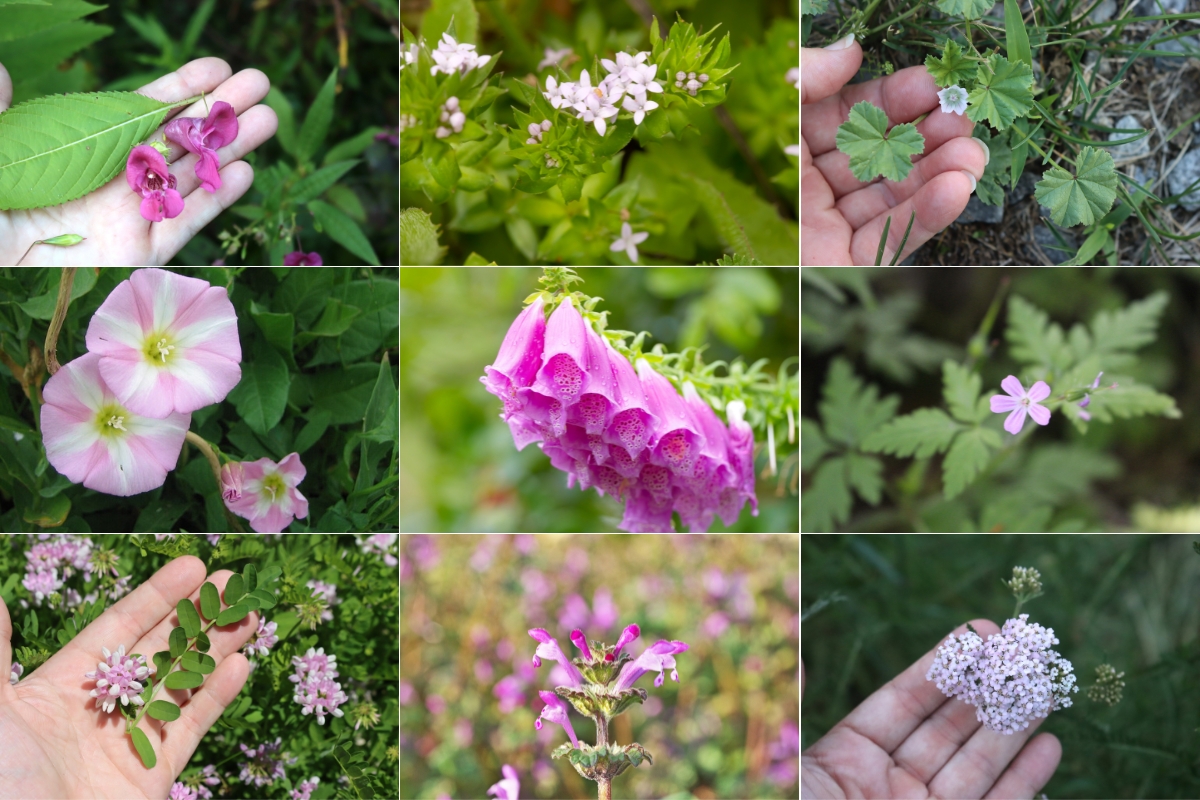
Table of Contents
- WEEDS WITH PINK FLOWERS
- Crown Vetch (Securigera varia)
- Dwarf Mallow (Malva neglecta)
- Field Bindweed (Convolvulus arvensis)
- Field Madder (Sherardia arvensis)
- Foxglove (Digitalis purpurea)
- Garden Valerian (Valeriana officinalis L.)
- Henbit Deadnettle (Lamium amplexicaule)
- Herb Robert (Geranium robertianum)
- Himalayan Balsam (Impatiens glandulifera)
- Himalayan Blackberry (Rubus armeniacus)
- Pink Purslane (Portulaca pilosa)
- Red Clover (Trifolium pratense)
- Redstem Filaree (Erodium cicutarium)
- Shining Geranium (Geranium lucidum)
- Spotted Knapweed (Centaurea stoebe)
- Spotted Lady’s Thumb (Persicaria maculosa)
- Spreading Dogbane (Apocynum androsaemifolium L.)
- Wood Sorrel (Oxalis Violacea)
- Wild Weed Identification Guides
This article is written by Morgan Hyde, a former reference librarian from Arizona. Working for the library refined her passion for learning and deep research—a passion that began in her rural AZ upbringing and continues in her work as a writer and editor.
Pink is not a very common flower color for plants growing in the wild—even those plants with pink in them tend to be just a shade or two away from white or purple. While pollinators enjoy these plants, it’s usually for their abundance of nectar rather than for any color attraction. As such, many plants with pink flowers have a tendency to form thickets or mats to give themselves a competitive chance against their neighbors.
Many plants on this list are edible and delicious! Two, though, are highly poisonous to humans and should be handled with care: Spreading Dogbane (Apocynum androsaemifolium L.), and Foxglove (Digitalis purpurea).
WEEDS WITH PINK FLOWERS
The weeds on this list can be found growing in a wide variety of places—drought-stricken land, river banks, forests, or meadows. On average, you’ll find them growing from knee to hip height. A few, including the Himalayan Blackberry, are monstrously large and will tower up above your head at heights reaching up to 15ft!
While many of the plants on this list are considered invasive in the US, it’s worthwhile to note that they’re not necessarily invasive in every state. Due to the size of the nation, plants native to the eastern side might be considered invasive in western regions. If you’re unsure if a plant is invasive in your county, there are many maps available online to show where invasive species have been reported.
Additionally, many of the plants on this list can look similar to non-invasive variants that come from the same genus. As it’s generally assumed that plants from the same genus are going to look similar, they aren’t listed. Pay careful attention to the key identification features for each plant, and do your research if you think you’ve stumbled across an invasive plant in your area.
All that to say, don’t be afraid of this list! Weedy though they may be, there are many plants here that are edible, medicinal, or useful in other ways—from plant dyes to erosion control, very few plants have nothing at all to contribute.
Crown Vetch (Securigera varia)
A highly attractive plant, Crown Vetch was originally introduced to North America in the 1950s for its looks. A few decades later it was planted on a wide scale to help combat erosion, particularly along roadways. However, the same properties that help stabilize soil are now recognized as invasive qualities: once Crown Vetch becomes established, it’s almost impossible to remove.
Crown Vetch isn’t recommended in gardens because of its invasive qualities and also because it has medium severity poison qualities—if large enough amounts of it are consumed, it can cause paralysis or even death. Every part of the plant from the seeds to the stems are harmful and should not be eaten. But this is only true for non-ruminants; cattle and goats can freely eat it without harm. Additionally, it does a wonderful job of attracting pollinators and is many pollinators’ best sources of food in dry areas.
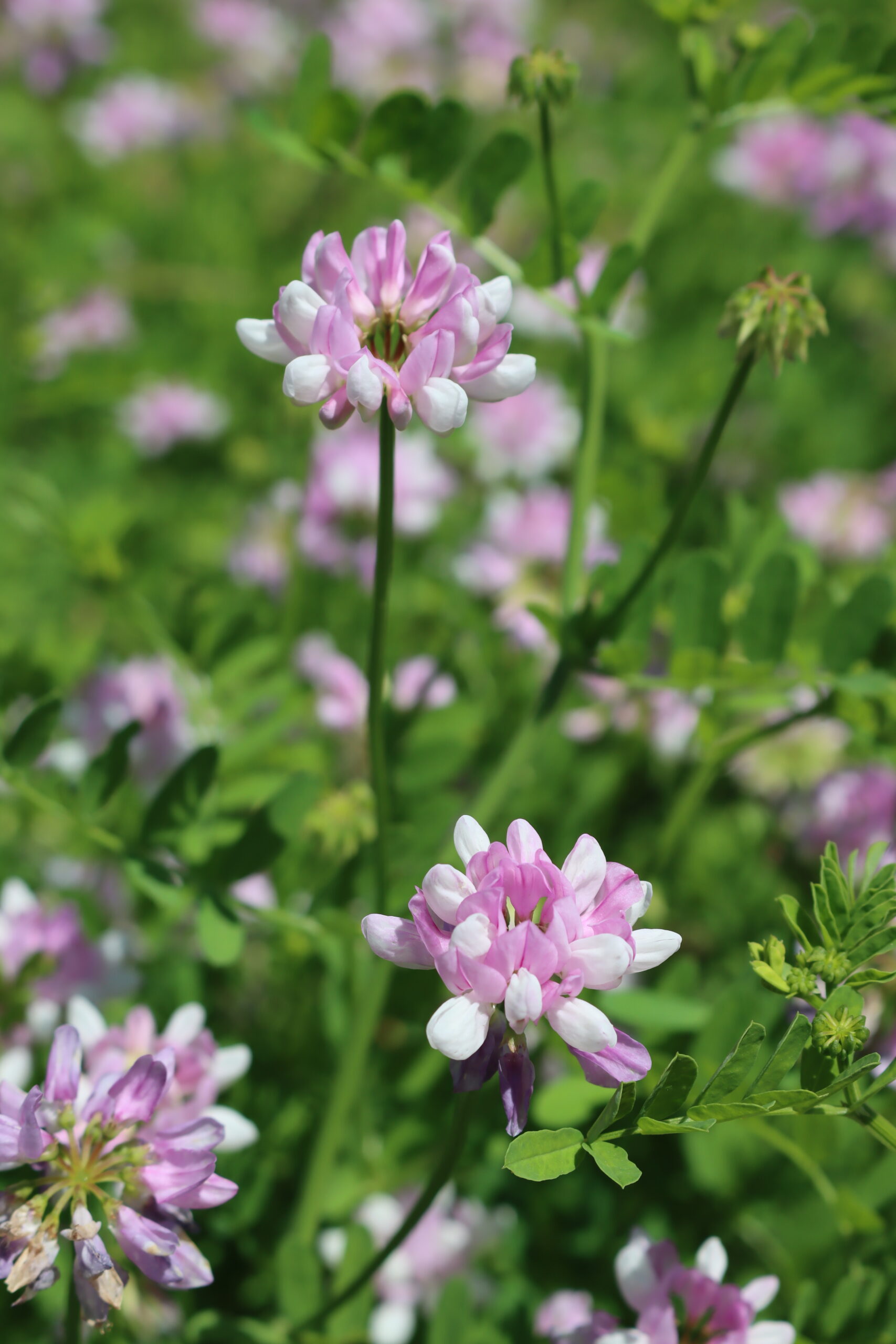
Key identification features
With identical leaves and a similar common name, it’s easy to confuse Crown Vetch with Carolina Vetch (Vicia caroliniana). However, the stems of the Carolina Vetch are hollow and don’t form vines or mats. Once the plants are in flower there won’t be any doubt which is which. Carolina Vetch is a native plant and is recommended for deliberate planting over Crown Vetch.
Flowers:
- 4-5 petals
- Pea-like
- Grow in clusters of 10-25
Seeds:
- Forms angular seed pods
- 1-7 legumes per pod
Leaves:
- Oblong
- Rounded base and tip
- Compound-shaped
- 15-25 opposite leaves per stem
General:
- Vining plant
- Can form dense mats
Here’s how to identify Crown Vetch (Securigera varia)
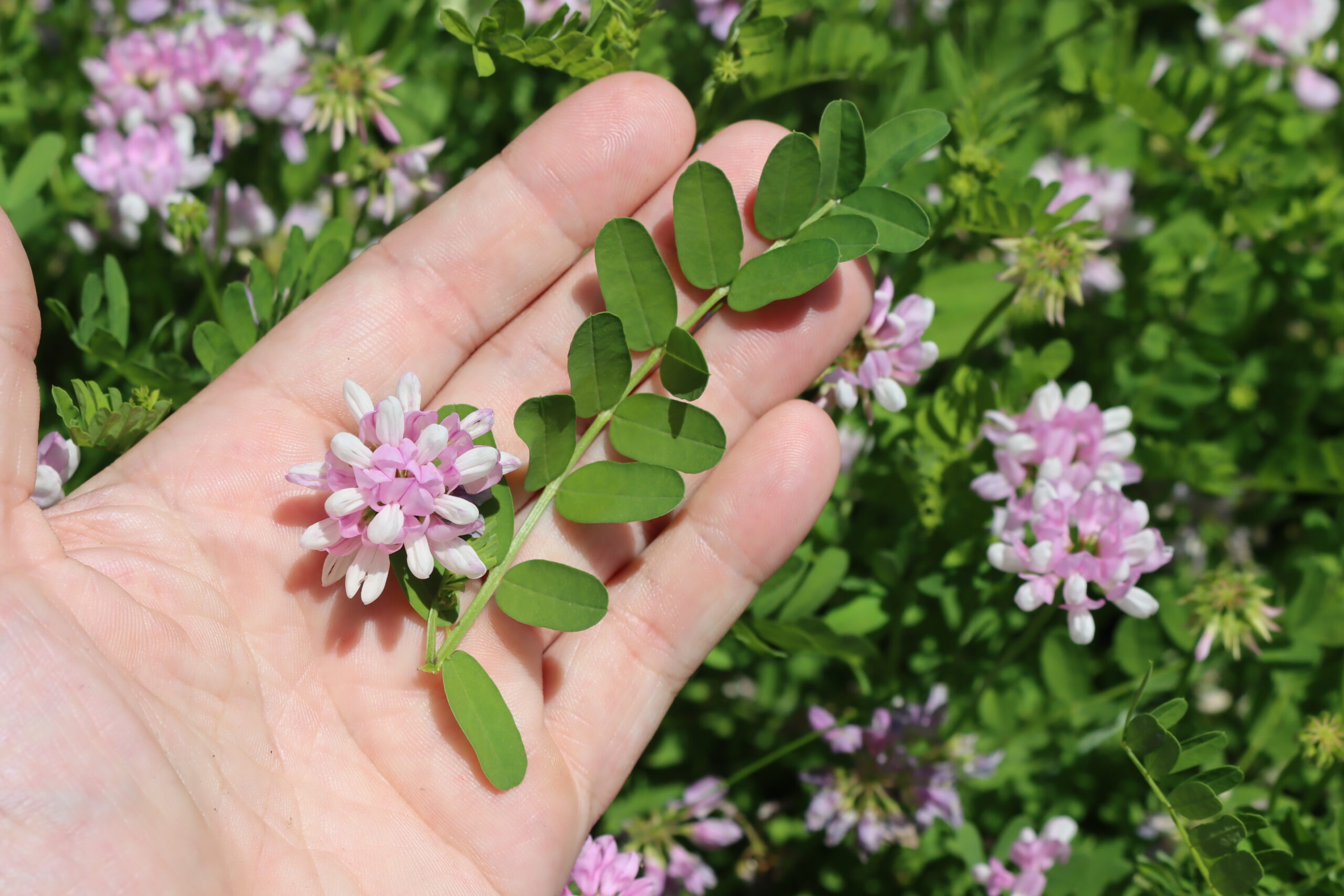
Dwarf Mallow (Malva neglecta)
Dwarf Mallow is also known by the common name “Cheeseweed” due to the shape its seedpods take—a flat, round, green pod that looks a bit like a cheese wheel or a pumpkin. The pods are even edible! They don’t taste like cheese, however, and instead have a nice, nutty flavor. You can add the flowers and leaves into salads as a replacement for lettuce, or cook the leaves as a soup thickener similar to okra.
Poultices made from the leaves or flowers of Dwarf Mallows are excellent for treating bruises or insect bites. When eaten, they can help reduce inflammation and act as a laxative.
Overall, Dwarf Mallow is an excellent plant to have around, though you may not want it in your garden. It’s an invasive plant and an aggressive grower. If you’re prepared to keep cutting it back, go for it!
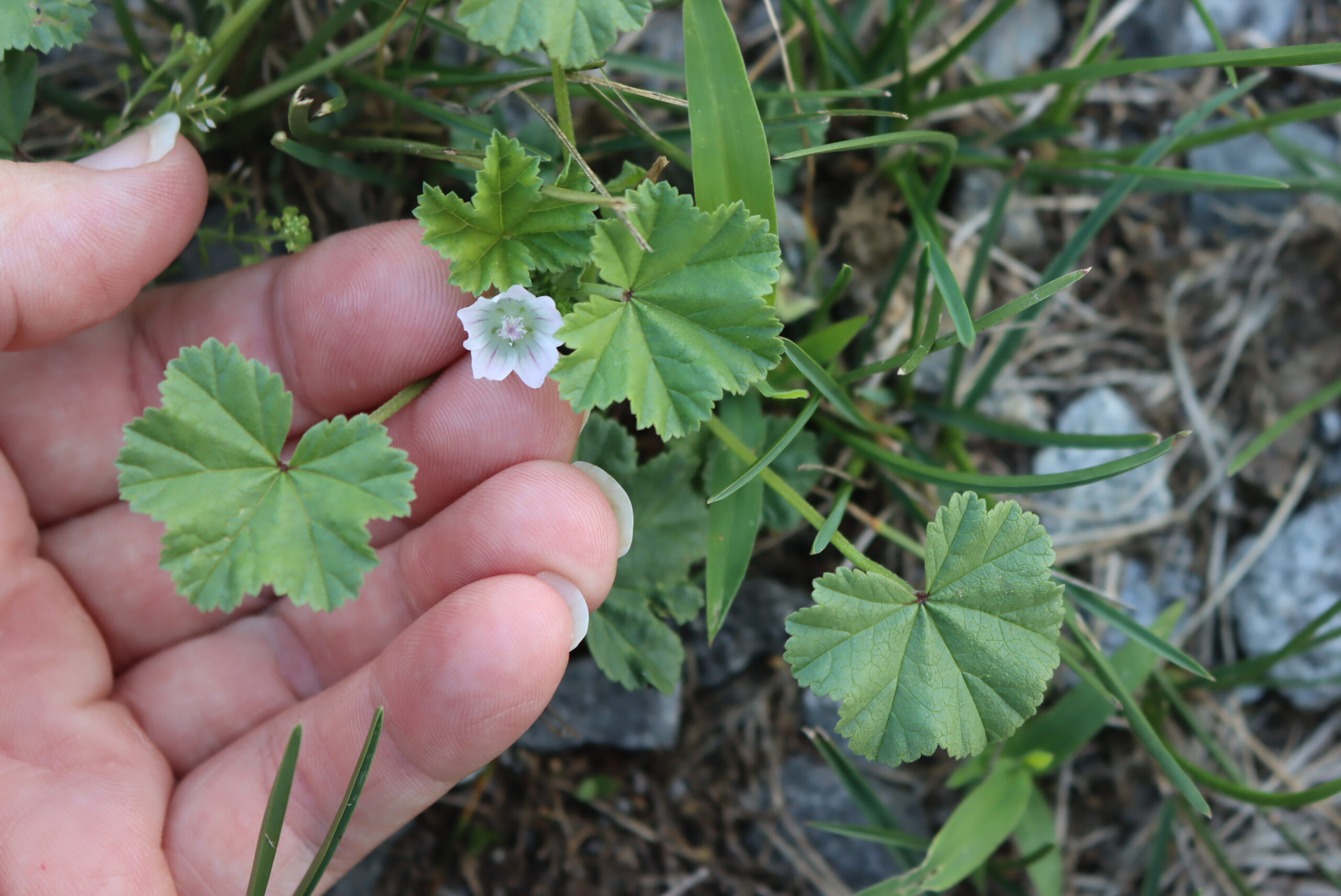
Key identification features
Flowers:
- Loosely cup-shaped
- 4-5 petals
- Notched petals
- The notches can make it look like there are more petals
Seeds:
- Forms a seed pod
- 10-12 seeds per pod
- Pod looks like a green cheese wheel
Leaves:
- Rounded
- Velvety
- Ruffled
Here’s how to identify Dwarf Mallow (Malva neglecta)

Field Bindweed (Convolvulus arvensis)
One of the most aggressive growers out there, Field Bindweed can root itself on (and through) hot asphalt! With a strong root system that can grow down to 30 feet and seeds that can stay viable in drought for up to 20 years, once it’s introduced, it’s incredibly difficult to get rid of.
Field Bindweed is useful when made into a tea—the flowers make a laxative, and the leaves make a solution good for washing spider bites or in managing female health. There isn’t much official data on how edible Field Bindweed is. However, as it is a part of the Morning Glory family, the same foraging precautions likely can apply: even with parts listed as edible, eat with caution and in small amounts.
Key identification features
Field Bindweed can look similar to several other plants, but is easily identifiable from them by the two, sharp, backwards pointing lobes at the base of each leaf. Two key species it gets confused with are Bugle Vine (Calystegia sepium), and Bitter Buckwheat (Fagopyrum tataricum), primarily through flower shape.
Flowers:
- Funnel or trumpet shaped
- Mostly white
- Pink hue or stripes
Leaves:
- Arrow-shaped
- Two lobes at base
- Point back to the stem
- Sharply pointed
General:
- Twining vine
- Two small bracts on flower stalk
- Extensive root network
Here’s how to identify Field Bindweed (Convolvulus arvensis)
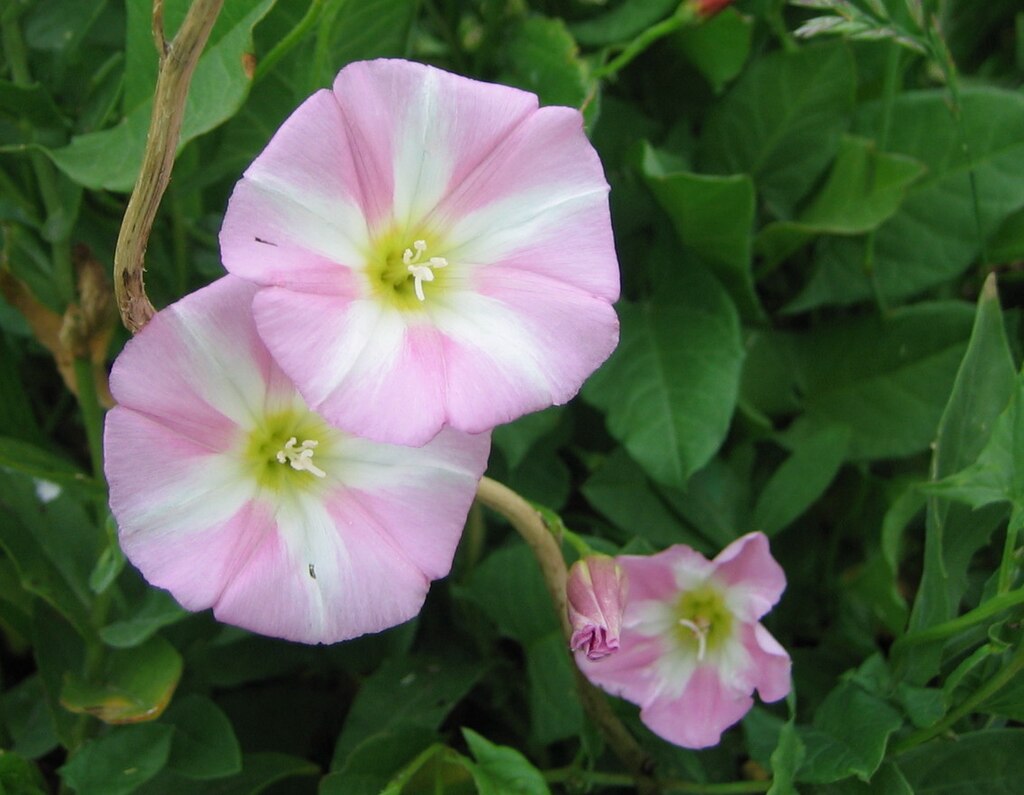
Field Madder (Sherardia arvensis)
Considered a weed due to its non-native status, Field Madder isn’t usually listed as an invasive plant in the US. It isn’t a particularly fast or aggressive grower, so you don’t need to worry about it when it pops up in your garden. The flowers clustered at the tops of the branches are lovely, but they do grow low to the ground as Field Madder tends to form itself into mats.
No edible or medicinal uses are recorded for Field Madder. But the roots can be used to make a weak red dye—in fact, it was the main source of red dye in Europe for centuries.
Key identification features
Field Madder can be confused with Smooth Bedstraw (Galium mollugo) or Catchweed Bedstraw (Galium aparine). The main difference between them is that the Bedstraws grow more leaves per node and the leaves don’t grow in a whirl pattern.
Flowers:
- 4 petals
- Grow in clusters
Leaves:
- Lanceolate in shape
- 4-6 leaves per node
- Grow in a whirl pattern
General:
- Square, hairy stems
Here’s how to identify Field Madder (Sherardia arvensis)
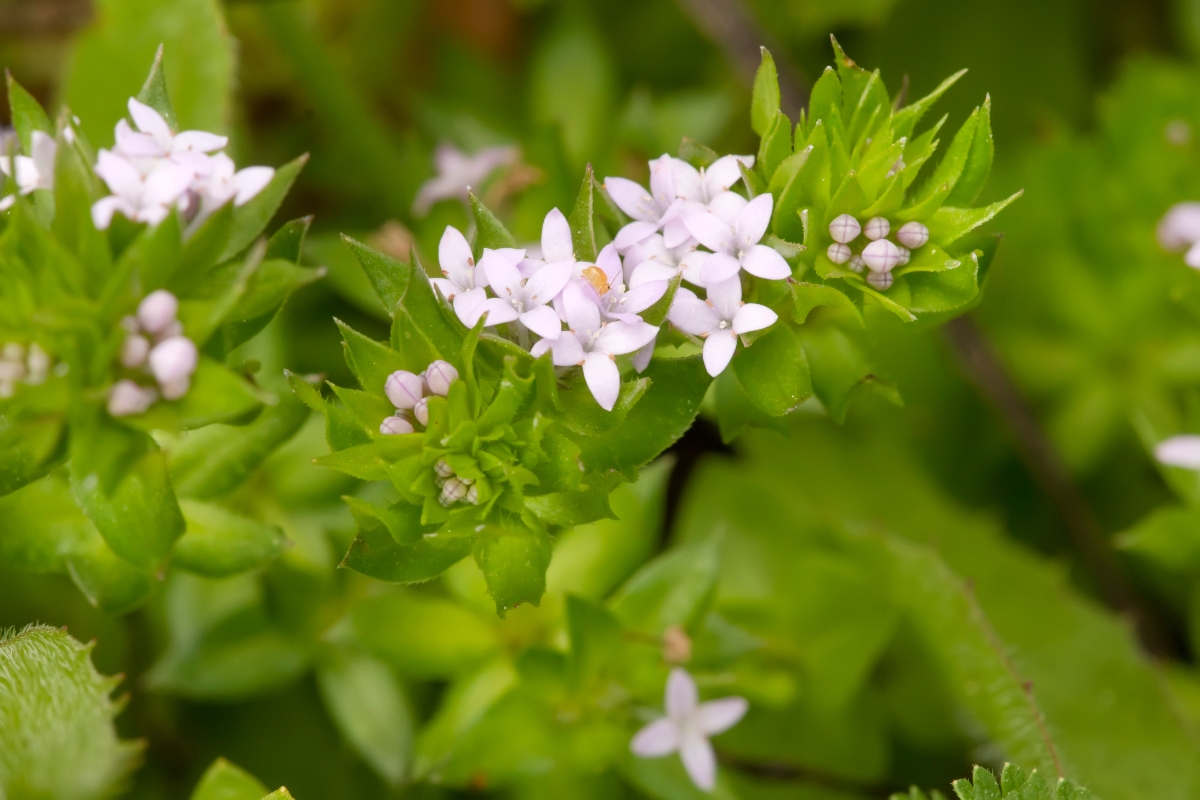
Foxglove (Digitalis purpurea)
A lovely plant with tall spikes of pink or purple flowers, you’ll be enchanted to see Foxglove out on your walks or mixed into garden borders. Bees love it too and will happily feast on its nectar during the early summer months. Native to Europe, Asia, and North Africa, it was brought over to the US as an ornamental and medicinal plant.
To this day, Foxglove plays an important role in the treatment of a variety of heart conditions—it can help slow and strengthen a heartbeat without increasing oxygen and reduce the strain put on the heart by lowering blood volume. However, there is a very fine line between dosages that are therapeutic and poisonous. It isn’t recommended for self-medication in any quantity. Every part of the plant is considered equally toxic and you should avoid eating it.
Key identification features
It can be easy to confuse Foxglove and anything from the Beardtongue (Penstemon spp.) family. Both grow tall spikes of tubular flowers and have very simple leaves. The easiest way to tell the difference is to look for mottling/spotting inside the throat of the flower—Penstemons have smooth, often white, interiors with a single hairy stamen poking out from the center.
Flowers:
- Funnel-shaped
- Drooping
- Grow in tall spikes
- Interior spots/speckles
Seeds:
- Brown capsules with numerous seeds
- Ridged, brown
Leaves:
- Basal rosette
- Downy
- Lanceolate
Here’s how to identify Foxglove (Digitalis purpurea)

Garden Valerian (Valeriana officinalis L.)
Despite the name, Garden Valerian will happily grow anywhere its seeds land and doesn’t need to be cultivated. It takes its name from its lovely umbrella of flowers that attract bees and butterflies during the hot summer months—it’s a garden delight! You will need to keep an eye on it, though, to prevent it from taking over.
Garden Valerian is a highly sought after plant as a sleep aid—teas made from the roots are particularly good at helping relieve insomnia. When submerged in a neutral alcohol, Valerian root tincture that can be added to drinks throughout the day to aid in relaxation. Some reports indicate Valerian can become addictive over time, so consider avoiding taking it every day.
Oil extracted from the leaves or roots has a strong flavor that can be added to foods like ice cream, cookies, or cakes. Garden Valerian has a musky or woodsy scent that many people find pleasant and you can find commercial scents that use it as a base.
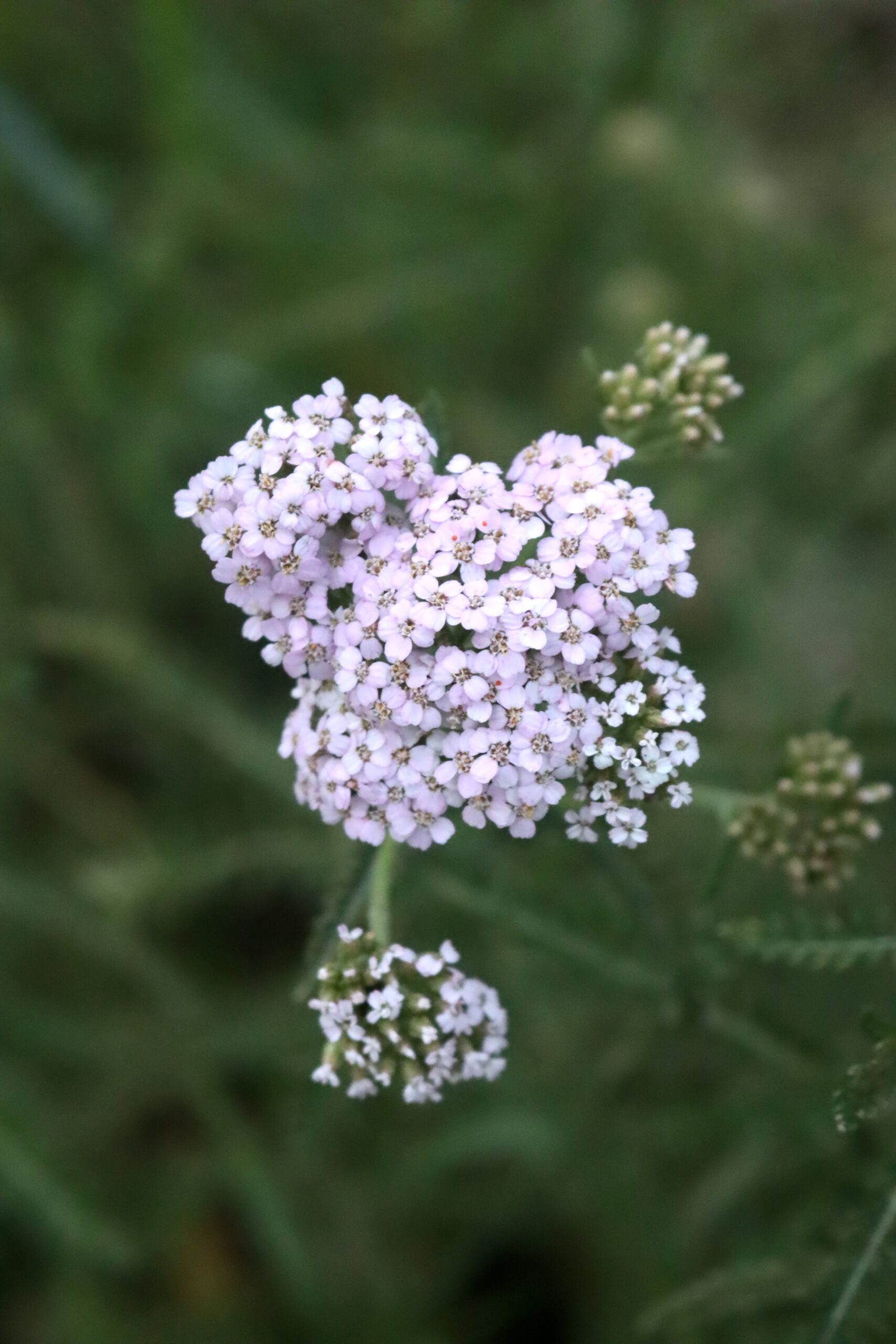
Key identification features
The general shape of Garden Valerian is matched in Common Yarrow (Achillea millefolium) and Queen Anne’s Lace (Daucus carota). However, on closer inspection, they look very different. Common Yarrow and Queen Anne’s Lace both have leaves that look more fern-like. Smell is the easiest way to distinguish Garden Valerian, however—once you know what it smells like (whether from a dry or fresh source), you can identify it anywhere!
Flowers:
- Star-shaped
- 4-5 petals
- Grow in umbel groups
- Fragrant
Seeds:
- Dandelion-like
Leaves:
- Lanceolate
- Grow in pairs plus one terminal leaf
- Fragrant
- Narrow lobes
General:
- Long, fragrant taproots
Here’s how to identify Garden Valerian (Valeriana officinalis L.)
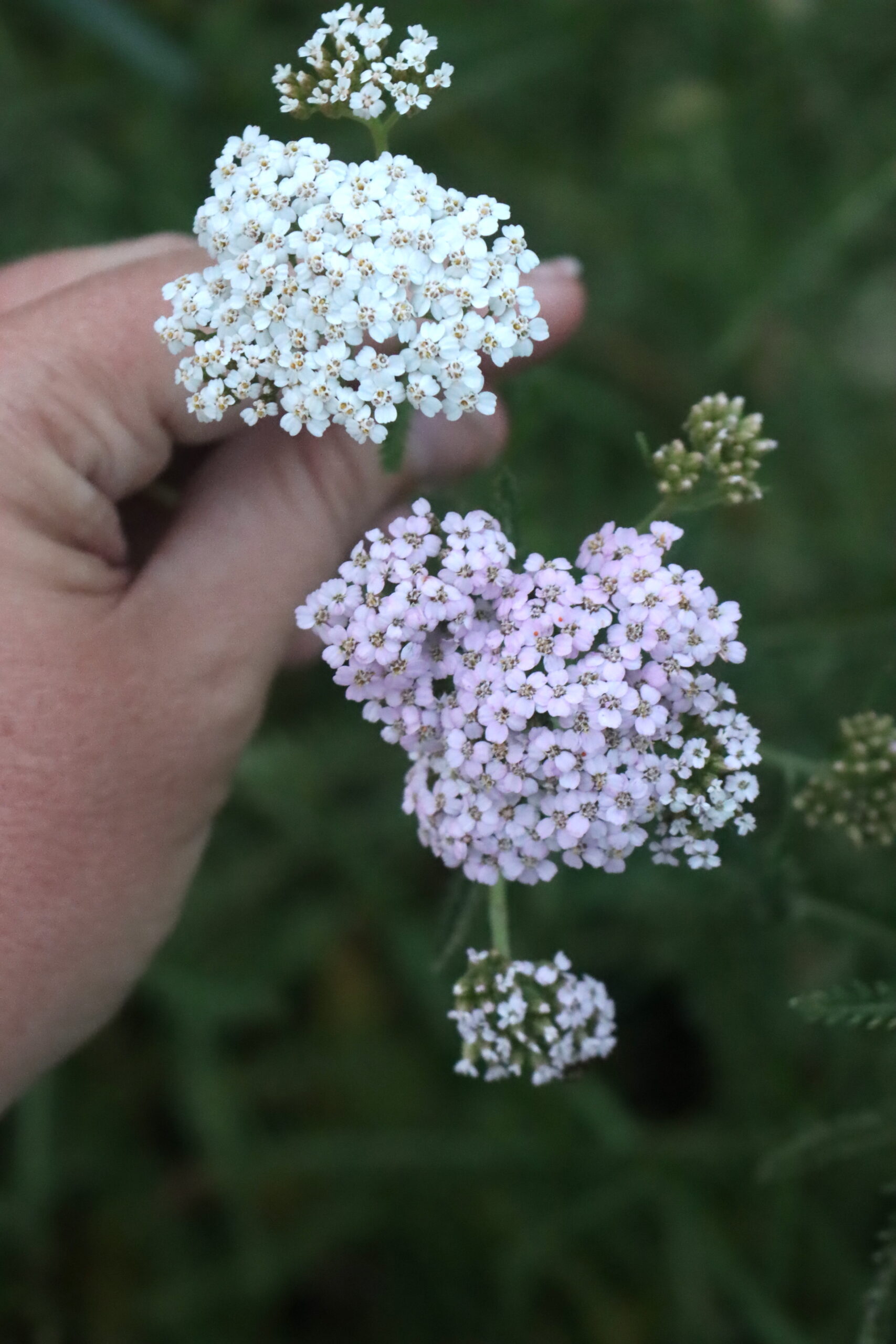
Henbit Deadnettle (Lamium amplexicaule)
Popular with hummingbirds, bees, and chickens alike! A member of the mint family but lacking that distinct flavor, Henbit Deadnettle is a phenomenal garden plant and a lovely addition during the spring and summer. It is, however, considered invasive in many parts of the US, and should be kept under careful control if you let it grow in your yard.
The leaves, stalks, and flowers of Henbit Deadnettle are edible and are said to be a bit like celery—crunchy with a mild sweet and peppery taste. You can eat it raw or use it as a potherb.
As a medicinal plant, it’s said to help reduce inflammation caused by rheumatism. It also acts as a mild laxative. Eating Henbit Deadnettle can cause you to sweat in greater volume and it may also act as a stimulant. It isn’t considered toxic at any dosage, but you may want to try only a bit of it first to see how you react—and make sure to drink lots of water!
Key identification features
Flowers:
- Tubular
- Two lips
- Lower lip is spotted
- Hairy
Leaves:
- Kidney shape
- Rounded teeth
- Lower leaves are on stalks
- Pairs form a circle around the stem
General:
- Square stems
Here’s how to identify Henbit Deadnettle (Lamium amplexicaule)
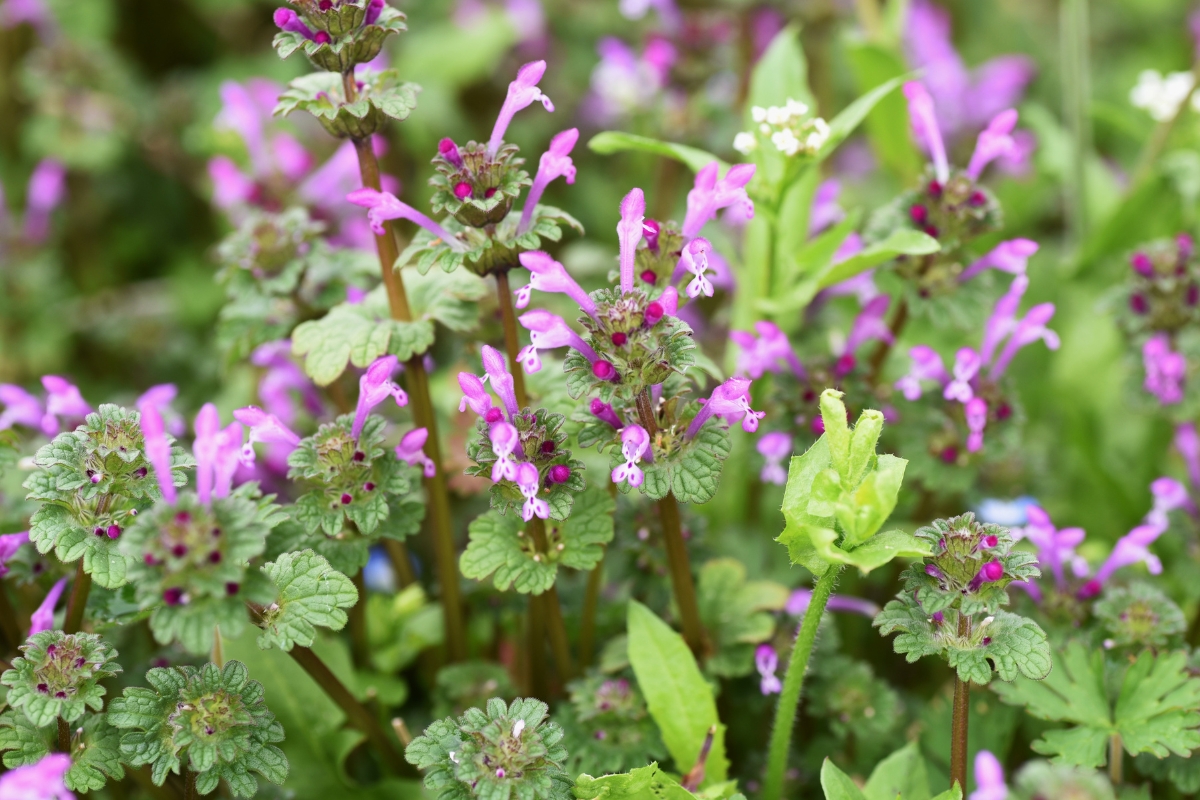
Herb Robert (Geranium robertianum)
Considered invasive on the western coast of the US, Herb Robert is a plant that can’t make up its mind—some days it’s a trailing, prostrate plant, and other days it’s erect, upright, and almost bushy. What it is every day, is a pungent plant. Going by a secondary common name of “Stinky Bob,” the leaves smell a bit like burning tires and are supposedly useful in repelling mosquitoes when crushed.
While it is invasive, you don’t need to worry about Herb Robert becoming established in your yard. Shallow roots mean that it’s easy to pull up at any stage. You may even want it around (if you can tolerate the smell)—traditionally Herb Robert has been used to treat upset stomachs, stem nosebleeds, and speed the healing process when pressed onto wounds. The leaves are also edible and can be made into teas, though the jury seems to be out on how much people enjoy the flavor.
Key identification features
Herb Robert can briefly be confused for Redstem Filaree (Erodium cicutarium) due to their similar structure and flower shape. However, Redstem Filaree has unique seeds (see below) and doesn’t smell as strongly as Herb Robert.
Flowers:
- 5 petals
- Star-shaped
- Grow at the ends of bare stems
Seeds:
- Forms brown seed capsules
- Tiny, less than 2mm long
- Seeds are ejected as the capsule dries
Leaves:
- Hairy
- Fern-like
- Overall triangular shape
- Turn red in the fall
General:
- Hairy stems
- Stems turn red in high light conditions
Here’s how to identify Herb Robert (Geranium robertianum)

Himalayan Balsam (Impatiens glandulifera)
Both in the US and in various places around the globe Himalayan Balsam is considered a highly invasive plant. Growing up to 10ft in moist areas, it spreads itself out and blocks light from reaching smaller plants, thus crowding out most native competition. As a part of the Impatiens genus, it also bears the common name of “touch-me-not” as the seed capsules explode open when lightly touched—launching dozens of seeds up to 23ft away!
Originally introduced to the US as a garden ornamental plant, Himalayan Balsam is a beautiful plant to behold. Bees also love it and will happily swarm any they come across for its bountiful nectar.
Its green pods and young seeds, leaves, and stems are all edible. Himalayan Balsam is regularly used in curries, can be added to stews, and the flowers can be made into jams. If you happen to find some growing in your area, feel free to dig it up and take it home! Just be sure to cover it first to prevent the seeds from escaping back out into the wild.
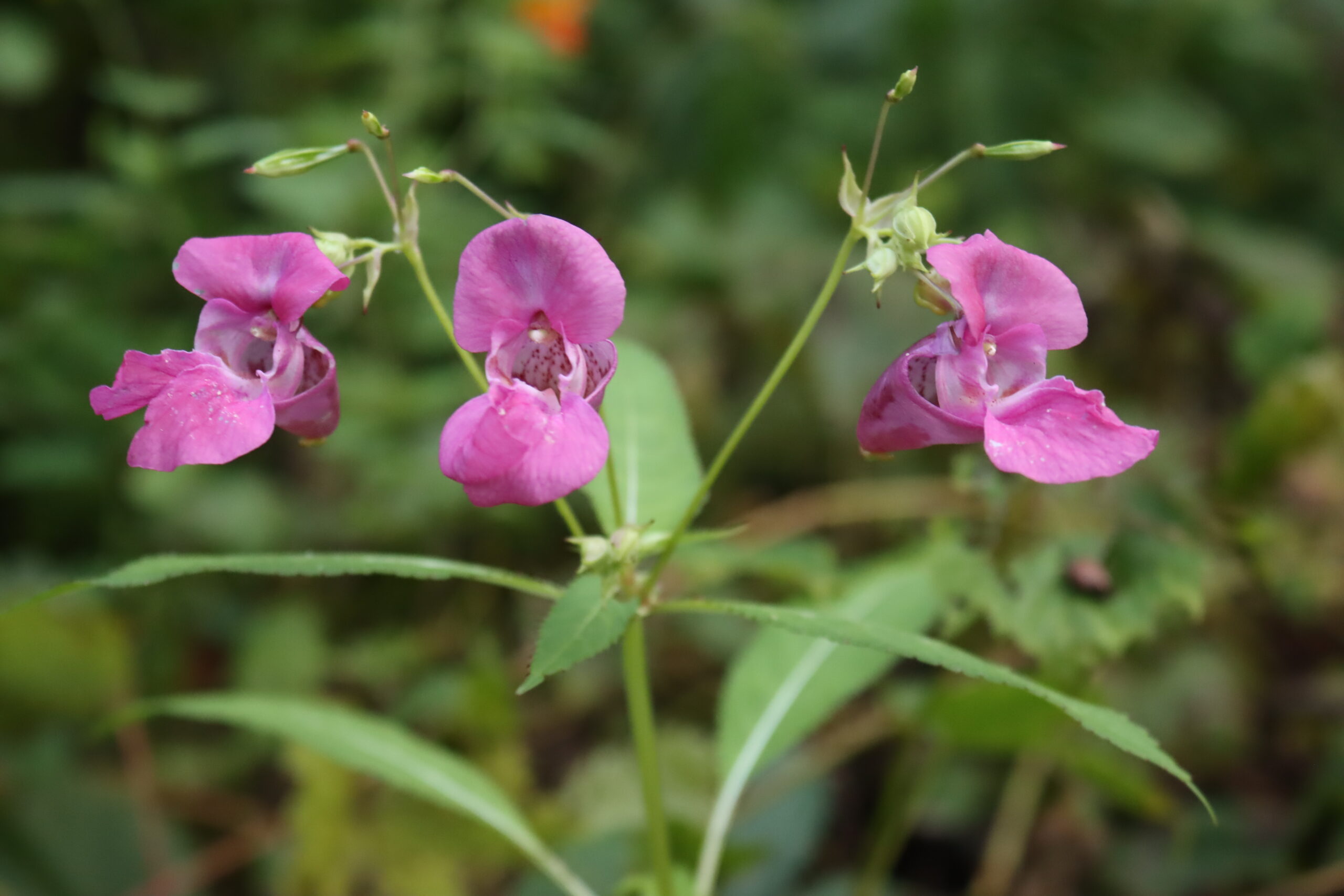
Key identification features
Flowers:
- Helmet-shaped
- 5 petals
- 5-10 per stem
Seeds:
- Forms oblong pods with 8-12 seeds
- Pods explode when ripe
Leaves:
- Lanceolate
- Toothed edges
- Strong musty smell when crushed
General:
- Reddish stems
- Hollow stems
Here’s how to identify Himalayan Balsam (Impatiens glandulifera)
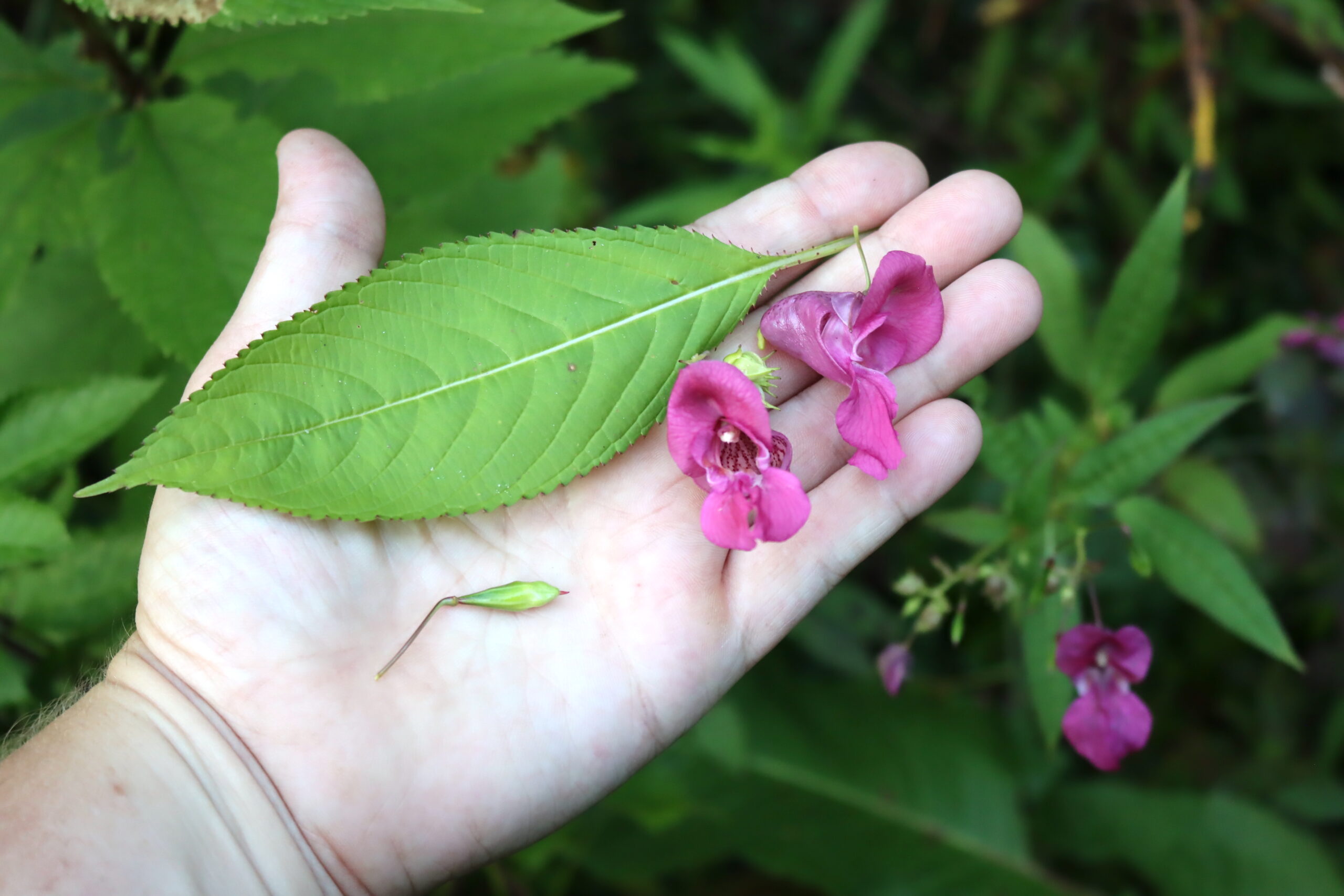
Himalayan Blackberry (Rubus armeniacus)
Perhaps the biggest plant on this list, Himalayan Blackberry grows up to 15ft in height. But it doesn’t stop there—the stems can grow up to 40ft in length and will start to trail along the ground once they get too tall. You’ll find Himalayan Blackberry growing in dense thickets near rivers and wetlands. It can provide excellent cover for ground-nesting birds (though studies have shown that most birds prefer native plants over it).
Controlling this plant is tedious as it can resprout from burned or broken canes and roots. Considered highly invasive, not only does it push out native undergrowth, it can also hinder the establishment of native tree saplings.
While Himalayan Blackberry is a nuisance in the wild, having it in your garden is a delight! Blackberries, much larger and sweeter than the native varieties, pop up on this plant in July and August. Just be prepared to fend off local wildlife that’s looking for a sweet treat!
Key identification features
Flowers:
- 5 petals
- Dozens of delicate stamens
- Small
Seeds:
- Large, sweet blackberries
Leaves:
- Groups of 5 per stem
- Rounded
- Toothed edges
General:
- Forms arching canes
- Stout thorns along stems
Here’s how to identify Himalayan Blackberry (Rubus armeniacus)
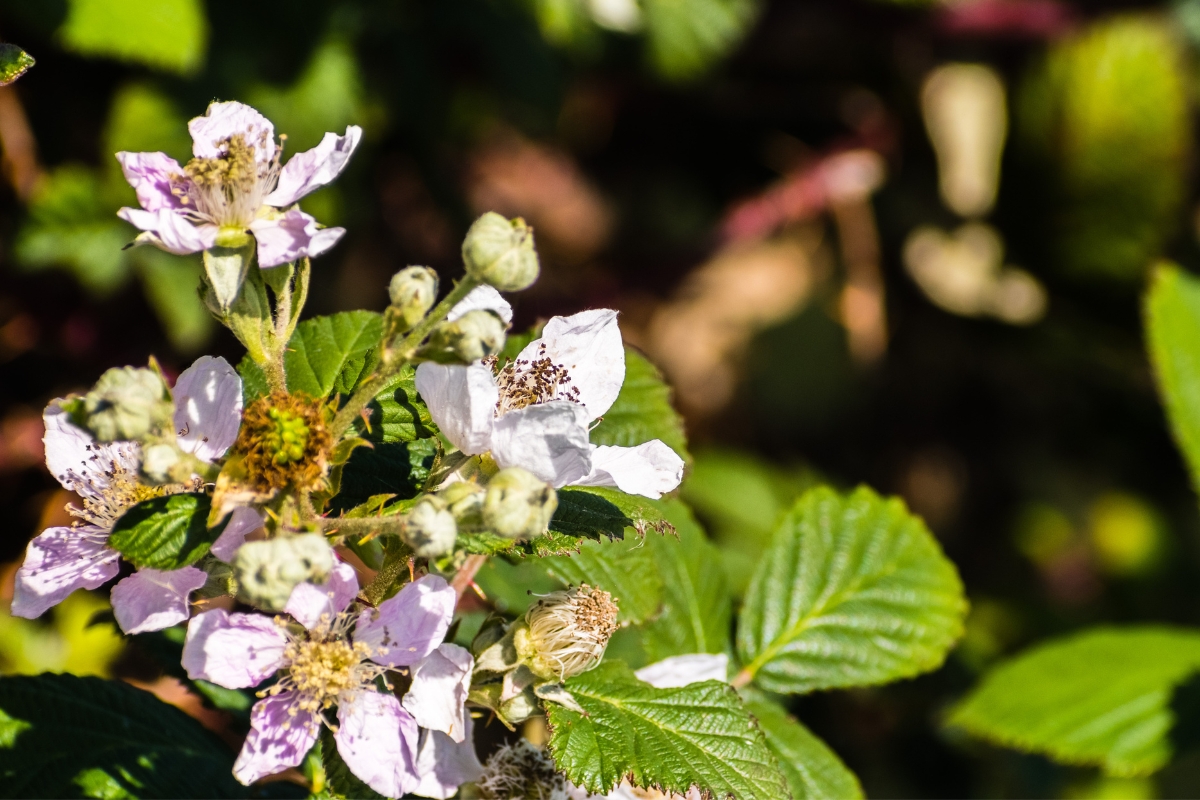
Pink Purslane (Portulaca pilosa)
Happily thriving even as the plants around it wilt, Purslane has all the hallmarks of a classic non-native weed and more—it pops up in sidewalk cracks, germinates with ease in disturbed soil, tolerates drought, and prefers to have the hottest weather it can find. However, despite its cheerful weedy ways, Pink Purslane is edible and enjoys a global appreciation for its uses in the kitchen.
Historically, Pink Purslane (and Purslane in general) has a long history of medicinal uses. Backed up by recent studies, we now know that it’s useful in regulating blood sugar and cholesterol, is antibacterial, and even acts as an anti-inflammatory. If you live somewhere where a lack of water and too much heat wrings the life out of your garden, Pink Purslane might be the choice for you.
Key identification features
You can easily mix-up Pink Purslane and Prostrate Spurge (Euphorbia maculate) when looking at the general shape of the plant. But when you look closer at the stems, you’ll find that Pink Purslane has soft, succulent stems and Prostrate Spurge has much woodier stems. If you’re still not sure, break a stem and look for a milky sap—if it’s there, it’s Prostrate Spurge.
Flowers:
- 5 heart-shaped petals
- Open in the morning
- Grow in leaf clusters
Seeds:
- Black or brown egg-shaped capsules
- Numerous seeds in each capsule
- Tiny
- Black
Leaves:
- Succulent
- Forms clusters at joints and stem ends
- Shape varies
- Tinged red or purple
Here’s how to identify Pink Purslane (Portulaca pilosa)
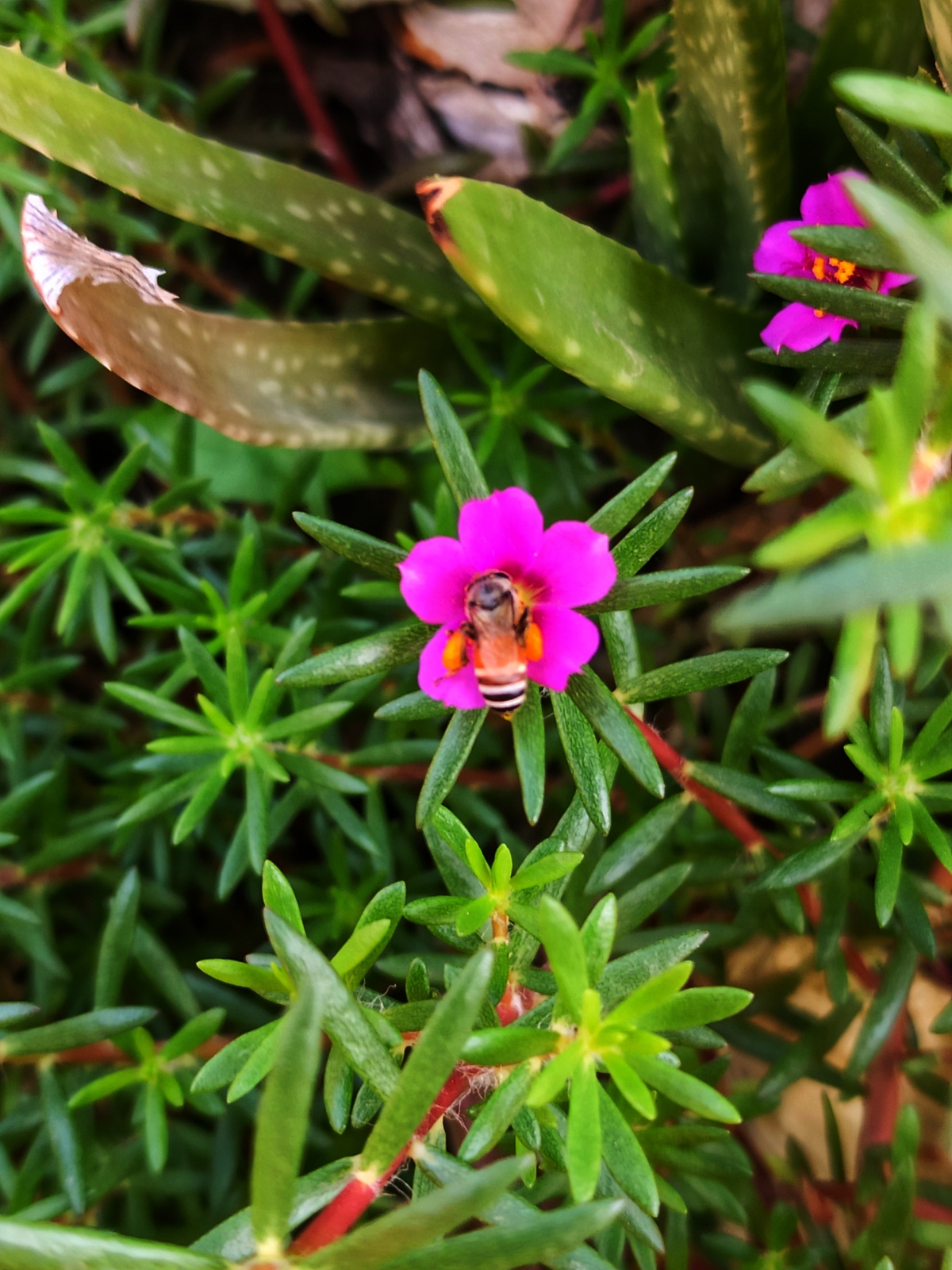
Red Clover (Trifolium pratense)
Red Clover is a bit of a misnomer as the flowers themselves are actually pink. It bears the distinction of being the only clover variant with pink flowers—making it easily distinguishable from other varieties.
Like other clovers, Red Clover has edible leaves and flower heads. Both can be eaten raw or cooked. When dried, the flowers and seeds can be ground up into a substitute for flour. Carrying a light, sweet flavor, the flowers tend to be the most popular part of the plant. However, it can be difficult to digest them, and it isn’t recommended for anyone who is pregnant or nursing.
A few different medical applications have been attributed to Red Clover. When eaten it’s said to help with menopausal symptoms, ulcers, and constipation and salves made from it can be applied to treat athlete’s foot or corns. Few studies have been done on how effective Red Clover is for these treatments, but each should be safe to try out.
Key identification features
Red Clover, in addition to looking like many other clovers in its genus, can be mixed-up with Wood Sorrel (Oxalis spp.). See below for a detailed description.
Flowers:
- Tubular
- Small
- Form a flower head
Seeds:
- Pods formed by flower heads
- Heart-shaped
Leaves:
- Compound
- Lanceolate
- White chevron in the middle
- 1-3 leaflets below each flower head
Here’s how to identify Red Clover (Trifolium pratense)
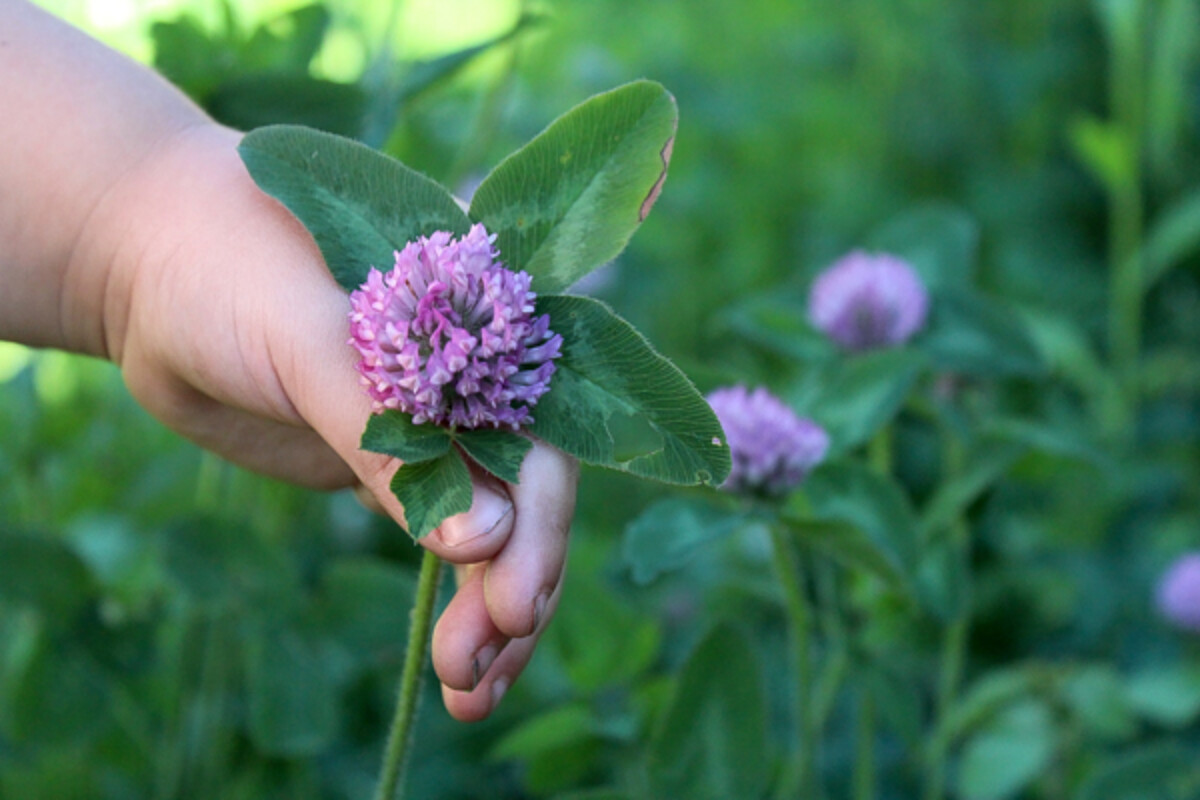
Redstem Filaree (Erodium cicutarium)
Anyone living near rangeland or sandy areas will immediately recognize Redstem Filaree by its seeds. Each seed is shaped like a musical note (or a stork’s head) with a very twisty stem; you’ll most commonly find them embedded in your socks after a hike. Non-native to the US, Redstem Filaree has become a nuisance in many areas because of how easily its seeds travel and how quickly it pushes native plants out.
All that to say, Redstem Filaree is a handy plant to have around: it’s great for pollinators and people alike! When picked young, the leaves are edible and have a flavor reminiscent of parsley. It even has some folk medicinal uses—among the Zuni people, infusions of the roots are taken for stomachaches, and poultices from the same are applied to rashes and sores.
Key identification features
Redstem Filaree does look a bit like Herb Robert (Geranium robertianum) and can be confused for it—see above.
Flowers:
- 5 petals
- Grow in clusters at the top of stems
Seeds:
- Needle-like pods
- Curly/twisty when ripe
- Shaped like a musical note
Leaves:
- Individual leaves divided into leaflets
- Alternate leaves along stems
General:
- Reddish stems
Here’s how to identify Redstem Filaree (Erodium cicutarium)
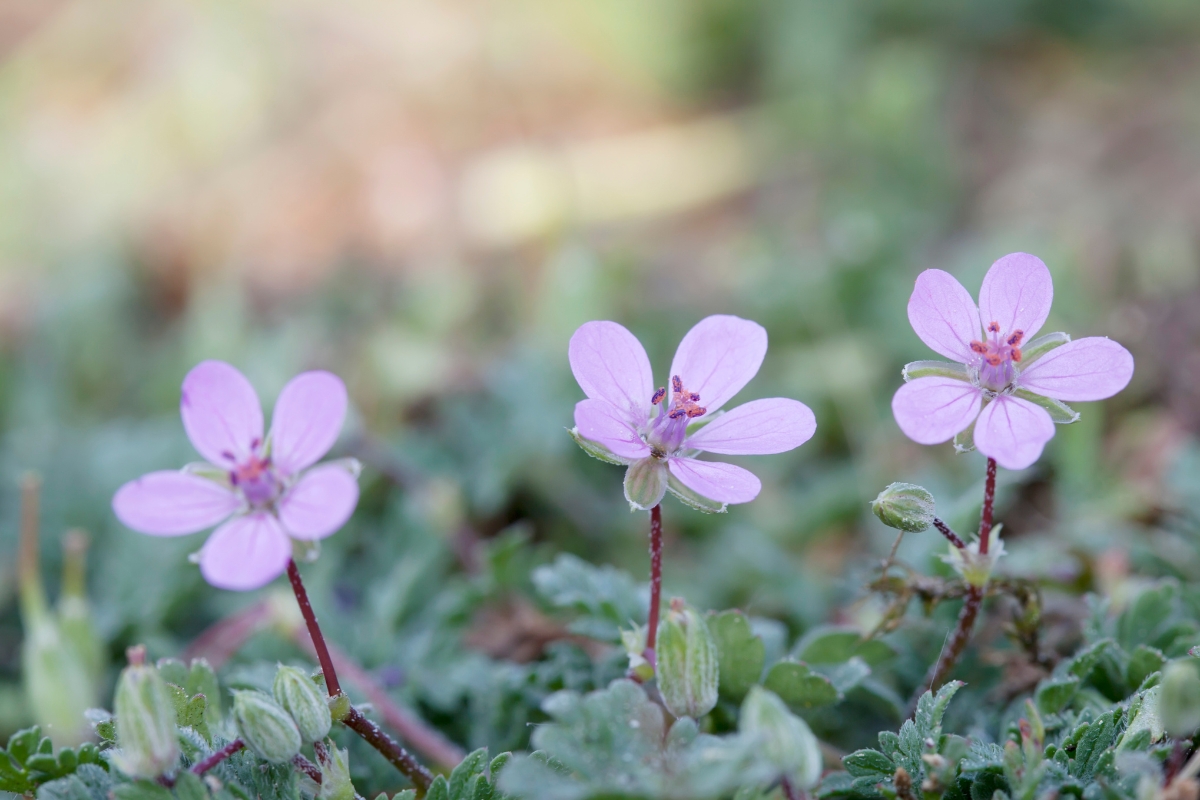
Shining Geranium (Geranium lucidum)
A smaller, more delicate variety of the geranium genus, Shining Geraniums shouldn’t be underestimated. In the Pacific Northwest they’ve been classified as a noxious weed due to how easily they can push native plants out of an area. With seeds that are launched from their pods and that have a habit of hitchhiking to new areas, it can take years of weeding to fully remove them from a plot of land.
Historically, Shining Geraniums were used as a diuretic and as an astringent—both internally and externally. However, these days they are generally considered to be a nuisance and aren’t recommended by any US group for planting in gardens.
Key identification features
Flowers:
- 5 petals
- Star-shaped
Seeds:
- Oval
- Red to brown
- Black projection
- Forcefully ejected when ripe
Leaves:
- Basal
- Shiny
- Rounded or kidney
- Lobed regions
- Each region contains an additional 3 lobes
General:
- Stems can be reddish
Here’s how to identify Shining Geranium (Geranium lucidum)
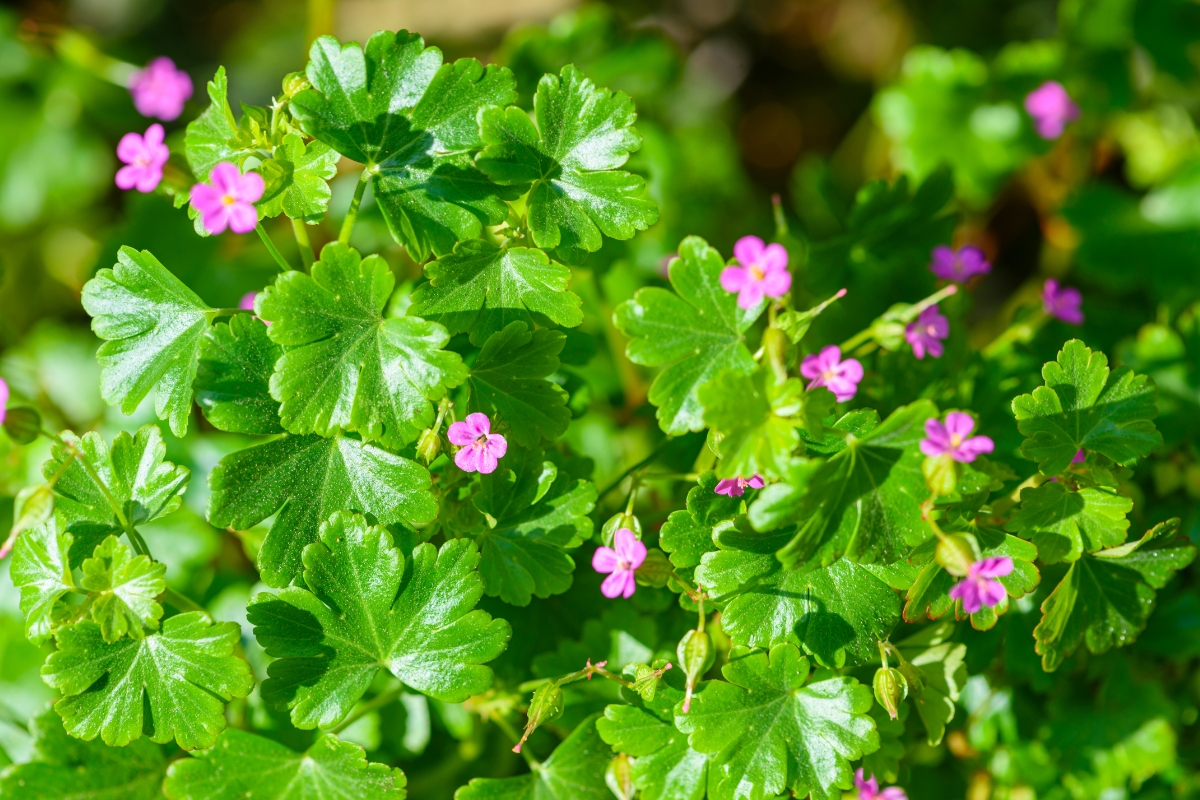
Spotted Knapweed (Centaurea stoebe)
Clumps of Spotted Knapweed can be spotted growing in any ground that’s been disturbed. Brought to the US by accident, the seeds continue to get mixed in with alfalfa and other crop plants to this day. With a long taproot, it’s said that Spotted Knapweed soaks up water from the surrounding area to parch nearby competition.
Unlike many of the plants on this list, there aren’t many uses attributed to Spotted Knapweed. The leaves and flowers have been reported to have nutritional value, but it’s likely they’re too bitter or fibrous to make eating them worthwhile. Bees adore this plant and its flowers are bright and cheerful. But that might be as far as it goes.
Key identification features
The flowers of Spotted Knapweed can look similar to Wild Bergamot (Monarda fistulosa) and also bear a vague resemblance to Bull Thistle (Cirsium vulgare). Upon closer inspection you’ll find that the “spiny” look of Spotted Knapweeds bracts are more like overlapping leaves in shape and appearance. You may not be able to tell the difference when it comes to comparing Wild Bergamot’s flowers and Spotted Knapweed’s—but the two have such different leaf shapes, it shouldn’t be difficult once you look a little lower.
Flowers:
- Thistle-like when it first blooms
- Numerous disc flowers
Seeds:
- Olive green to brown fruit
- 1 seed per fruit
- Bristly pappus on each seed
Leaves:
- Basal rosette
- Sparse on the flower stems
- Base leaves are irregularly lobed
- Upper leaves are finely dissected
General:
- Green/purple striped flowering stems
Here’s how to identify Spotted Knapweed (Centaurea stoebe)
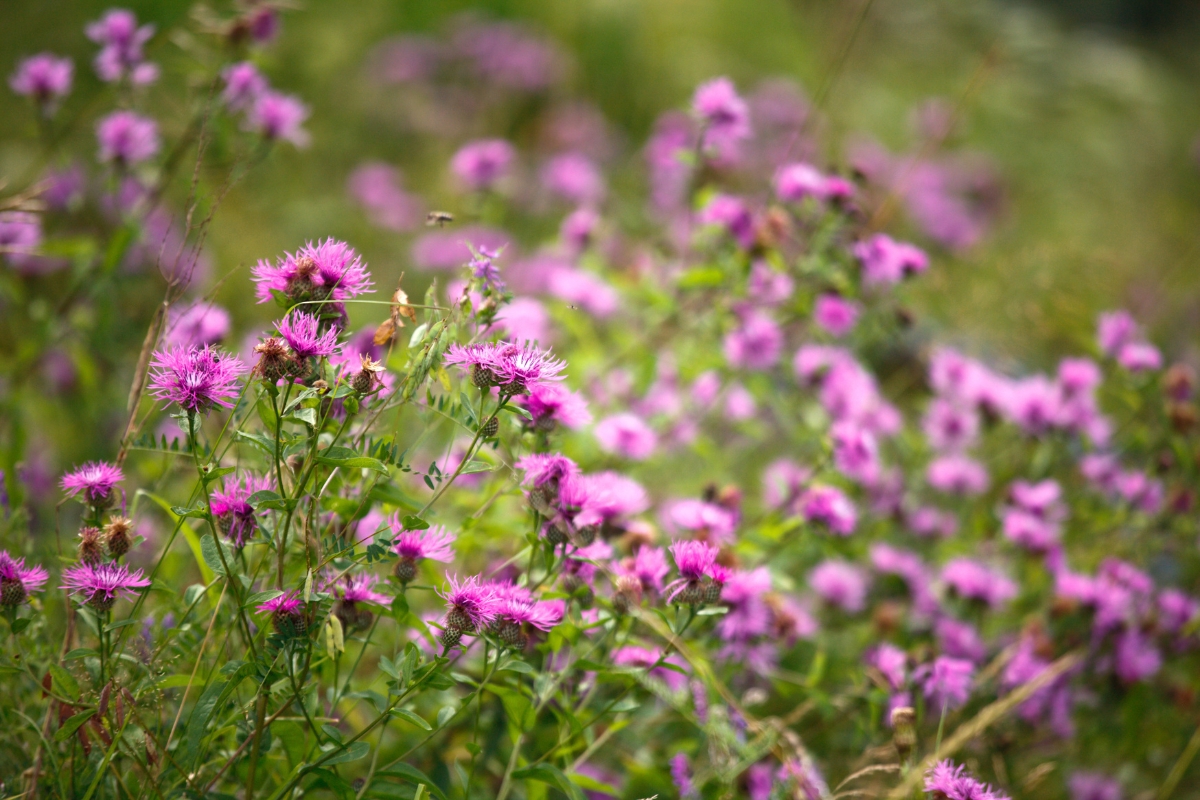
Spotted Lady’s Thumb (Persicaria maculosa)
Many folktales exist for Spotted Lady’s Thumb, most of them revolving around the dark spot in the center of its leaves. The tales range from the mythic to the horrific but mostly end with a woman pressing her fingers into the leaves, leaving behind a fingerprint.
In the US it is a non-native plant and generally considered highly invasive. Be cautious about pulling up any you come across, however, as there are native variants that look similar.
Spotted Lady’s Thumb has a long list of uses as a folk remedy, dating back thousands of years in some instances. Poultices made from the leaves are said to be useful in treating poison ivy or even warding off insects. The leaves and seeds are edible and can be eaten raw or cooked. Spotted Lady’s Thumb is known to interfere with some medications, however, so check with a doctor before consuming any of it casually or medicinally.
Key identification features
Flowers:
- Grow in long clusters
- 4-5 petals
- Tubular with petals curved inwards
Seeds:
- 3 edged
- Teardrop shaped
- Shiny black
Leaves:
- Long, tapering
- Dark, oval spot in the middle
- Short, hairy fringe
General:
- Thin, round stems
- Swollen joints
Here’s how to identify Spotted Lady’s Thumb (Persicaria maculosa)
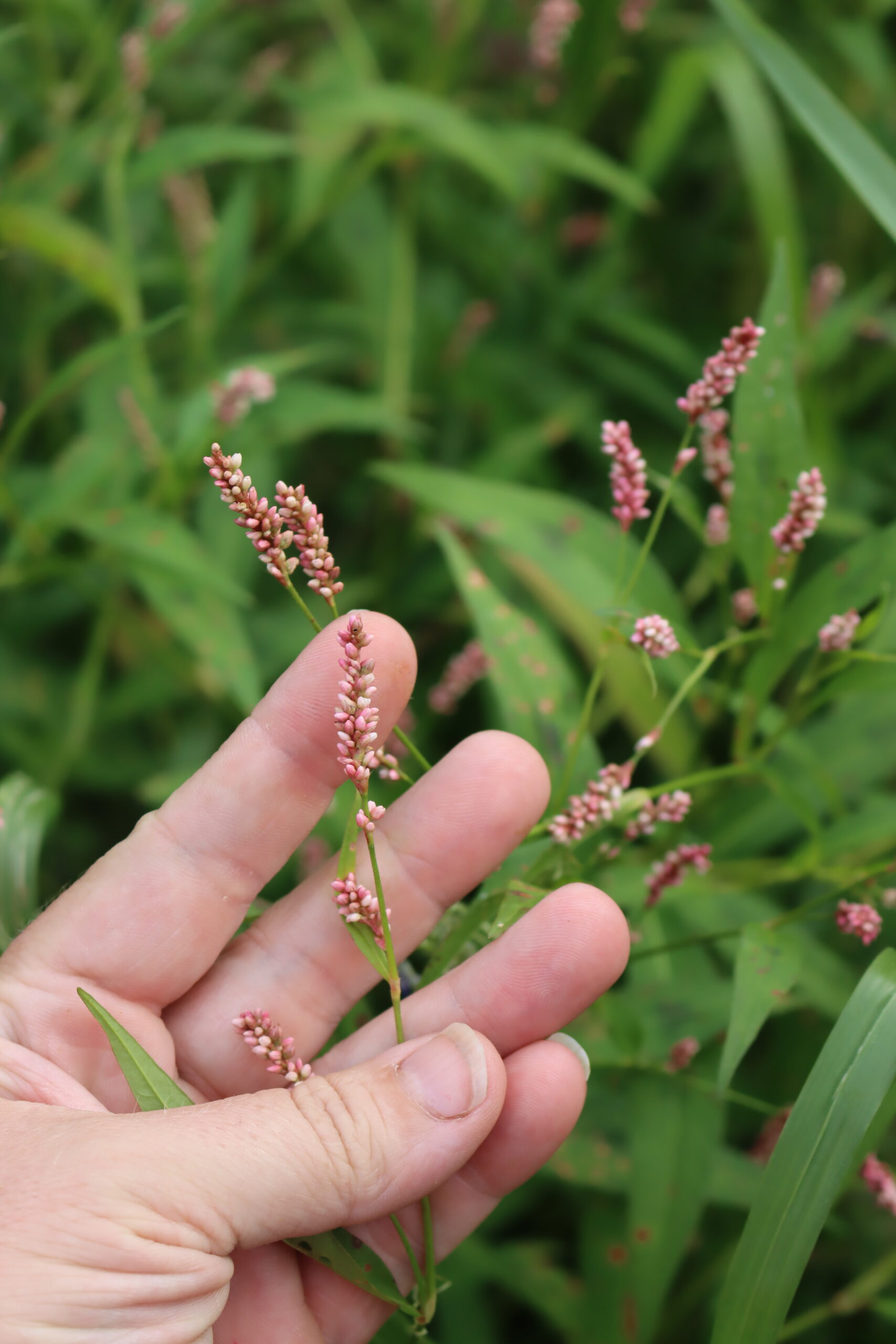
Spreading Dogbane (Apocynum androsaemifolium L.)
The most dangerous plant on this list, Spreading Dogbane is considered to have a severely toxic status. Every part of the plant is highly poisonous and should not be consumed—even the milky sap can cause blisters when it comes in contact with skin. While Spreading Dogbane has a long history as a medicinal plant among Native Americans, no historic treatments are currently recommended.
It’s primarily because of its toxicity that Spreading Dogbane is considered a weed. Objectively, it’s a lovely plant with delicate flowers and vibrant green leaves. Pollinators love it too, and it can be useful in attracting them to your area. It’s not well suited to small gardens as it likes to spread out through underground rhizomes, but might be well suited to a larger yard.
Key identification features
Flowers:
- Bell-shaped
- 5 petals
- Dark pink stripes on the interior
Seeds:
- Cylindrical follicles split open when ripe
- Each seed is tufted
Leaves:
- Turn yellow in the fall
- Elliptical
- Paler underside
General:
- Milky sap
- Red stems
Here’s how to identify Spreading Dogbane (Apocynum androsaemifolium L.)

Wood Sorrel (Oxalis Violacea)
Unlike the previous entry, Wood Sorrel is one of the most edible plants on this list—every part can be eaten and enjoyed raw or cooked. Because of the presence of oxalic acid (from which the plant takes its scientific name), it should only be eaten in moderation as it can become toxic in high quantities.
Wood Sorrel holds a long history as a medicinal plant and generally is made into teas to treat a wide variety of ailments. When made into a poultice, Wood Sorrel can also be used externally to reduce inflammation.
Key identification features
Wood Sorrel is often confused for a few different clover plants: Red Clover (Trifolium pratense) which is listed above, White Clover (Trifolium repens), and Crimson Clover (Trifolium incarnatum). Check for heart-shaped leaves with a center crease that allows them to fold in half—these will distinguish the plant as Wood Sorrel and not a clover.
Flowers:
- 5 petals
- Fused petals at the base
- Light yellow center
Seeds:
- Okra-like pods
Leaves:
- Heart-shaped
- Creased in the middle
- Can fold in half
- 3-10 leaflets per leaf
Here’s how to identify Wood Sorrel (Oxalis Violacea)
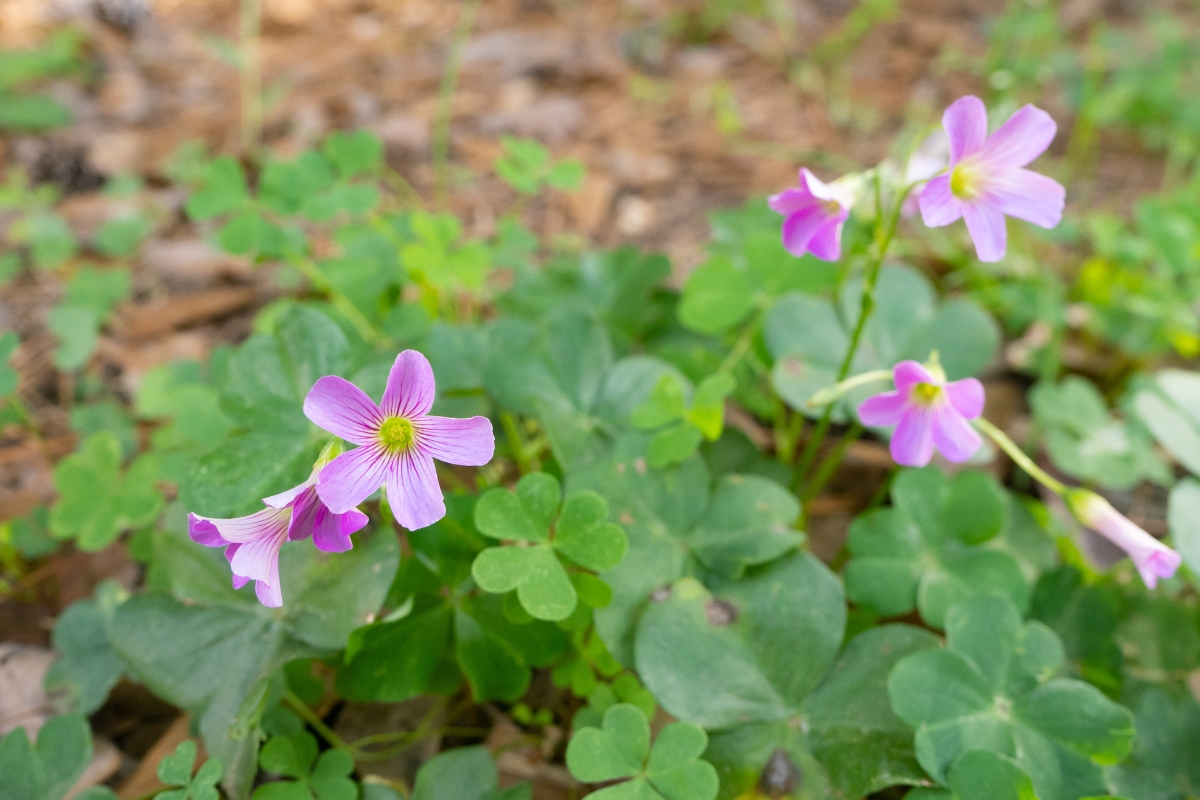
Wild Weed Identification Guides
Looking for more guides to help you identify (and use) the wild weeds all around us?
- Weeds with Purple Flowers
- Weeds with Orange Flowers
- Weeds with White Flowers
- Weeds with Blue Flowers
- Weeds with Yellow Flowers
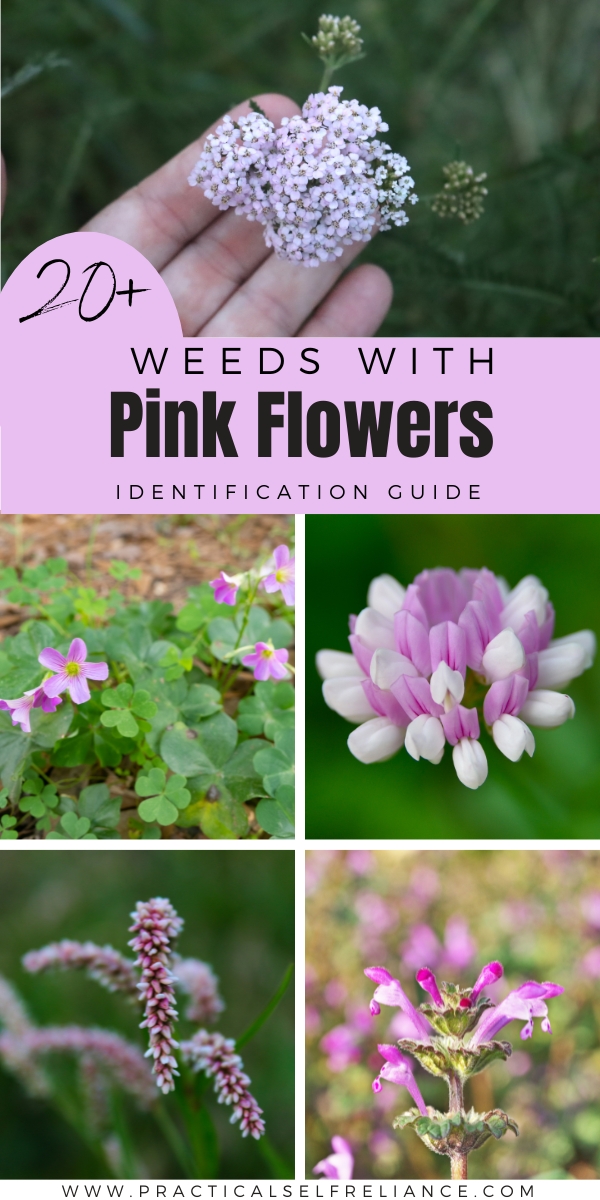

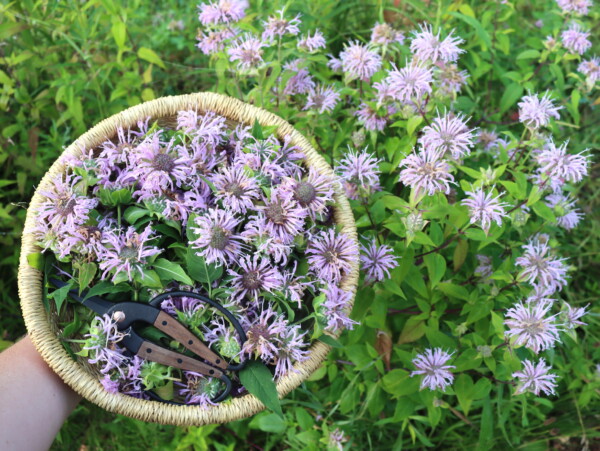
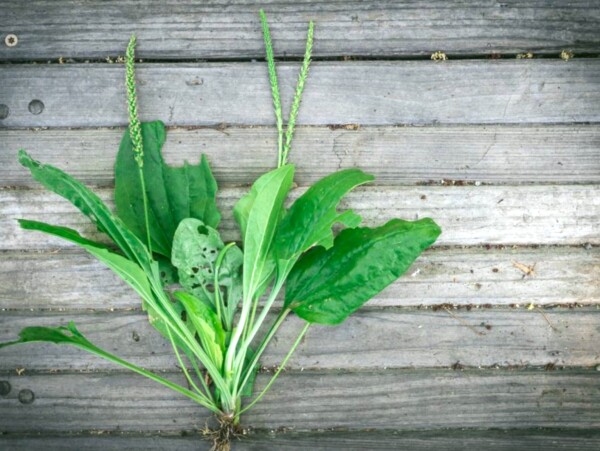
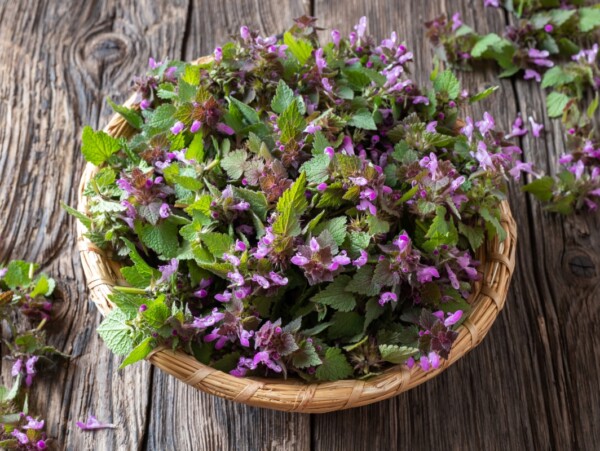










Thank you so much for the clear and concise identification of pink flower weeds, I found what I was looking for and it is Himalayan Balsam which is growing on the Burn at the bottom of my garden .
Lovely! That’s a fun one, and a great medicinal: https://practicalselfreliance.com/himalayan-balsam/